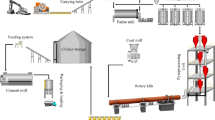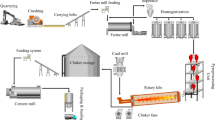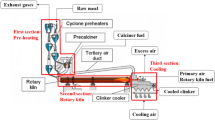Abstract
In Turkey, cement producing is one of the most important sectors in terms of energy consuming and costs. Owing to this reason, using energy efficiently and a decline in energy consumption have an importance in this sector.
This study aims to make energy and exergy analysis of a cement factory in Adana and to realize the cost of energy efficiency, by using the actual operational data. According to energy and exergy analysis, the energy efficiency value for the raw mill is obtained to be 69 % in this study, whereas the exergy efficiency value for that is found to be 11 %.
Access this chapter
Tax calculation will be finalised at checkout
Purchases are for personal use only
Similar content being viewed by others
References
Moran MJ (1982) Availability analysis. Prentice-Hall, New Jersey
Szargut J, Morris DR, Steward FR (1998) Exergy analysis of thermal and metallurgical processes. Hemisphere Publishing Corporation, New York
Dincer I (2000) Thermodynamics, exergy and environmental impact. Energ Source 22:723–732
Dincer I (2002) The role of exergy in energy policy making. Energ Policy 30:137–149
Bejan A (1988) Advanced engineering thermodynamics. Wiley, New York
Kotas TJ (1985) The exergy method of thermal plant analysis. Anchor Brendon Ltd., Tiptree, Essex
Dincer I, Hussain MM, Al-Zaharnah I (2003) Energy and exergy use in the industrial sector of Saudi Arabia. Proc Inst Mech Eng 217:481–492
Dincer I, Hussain MM, Al-Zaharnah I (2004) Energy and exergy utilization in transportation sector of Saudi Arabia. Appl Thermal Eng 24:525–538
Cornelissen RL (1997) Thermodynamics and sustainable development: the use of exergy analysis and the reduction of irreversibility. PhD thesis, University of Twente, Twente
Wall G (2003) Exergy tools. In: Proceedings of the Institution of Mechanical Engineers. Wilson applied science and technology abstracts plus text, 217:125–136
Torres EA, Gallo WLR (1998) Exergetic evaluation of a cogeneration system in a petrochemical complex. Energy Convers Manag 16–18:1845–1852
Moran MJ (1999) Engineering thermodynamics. In: Kreith F (ed) Mechanical engineering handbook. CRC Press LLC, Boca Raton
Çelen F (1998) Exergy analysis in a rotary burner with pre-calcination in dry system cement production. MS Thesis, Kırıkkale University Institute of Science & Technology
Gürüz HK (1977) Mass and energy balances in cement factories. J Chamber Chem Eng (Turkish)
Author information
Authors and Affiliations
Corresponding author
Editor information
Editors and Affiliations
Nomenclature
Nomenclature
- E:
-
Energy (kJ)
- \( \dot{E} \) :
-
Energy rate (kW)
- Ex:
-
Exergy (kJ)
- \( \dot{E}x \) :
-
Exergy rate (kW)
- h:
-
Specific enthalpy (kJ/kg)
- I:
-
Irreversibility, exergy consumption (kJ)
- \( \dot{I} \) :
-
Irreversibility rate, exergy consumption rate (kW)
- m:
-
Mass (kg)
- \( \dot{m} \) :
-
Mass flow rate (kg/s)
- P:
-
Pressure (Pa)
- Q:
-
Heat transfer (kJ)
- \( \dot{Q} \) :
-
Heat transfer rate (kW)
- s:
-
Specific entropy (kJ/kg K)
- \( \dot{S} \) :
-
Entropy rate (kW)
- T:
-
Temperature (K)
- W:
-
Work (kJ)
- \( \dot{W} \) :
-
Work rate or power (kW)
- η:
-
Energy (first law) efficiency (%)
- ε:
-
Exergy (second law) efficiency (%)
- ψ:
-
Flow exergy (kJ/kg)
- c:
-
Clay
- dest:
-
Destroyed
- d:
-
Gas dust
- f:
-
Farine
- gen:
-
Generation
- g:
-
Gas
- in:
-
Input
- m:
-
Moisture
- l:
-
Limestone
- la:
-
Leaking air
- mc:
-
Moisture clay
- ml:
-
Moisture limestone
- r:
-
Return from separator
- s:
-
Steam
- out:
-
Outlet, existing
- 0:
-
Dead state or reference environment
Rights and permissions
Copyright information
© 2014 Springer International Publishing Switzerland
About this chapter
Cite this chapter
Kandilci, H.G., Saraç, H. (2014). Investigation of Energy Efficiency by Making Exergy Analysis in the Cement Sector. In: Dincer, I., Midilli, A., Kucuk, H. (eds) Progress in Exergy, Energy, and the Environment. Springer, Cham. https://doi.org/10.1007/978-3-319-04681-5_31
Download citation
DOI: https://doi.org/10.1007/978-3-319-04681-5_31
Published:
Publisher Name: Springer, Cham
Print ISBN: 978-3-319-04680-8
Online ISBN: 978-3-319-04681-5
eBook Packages: EnergyEnergy (R0)




